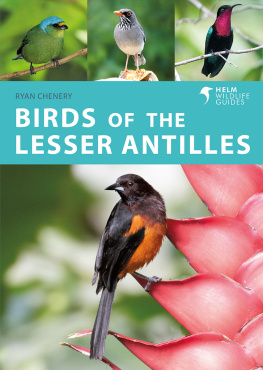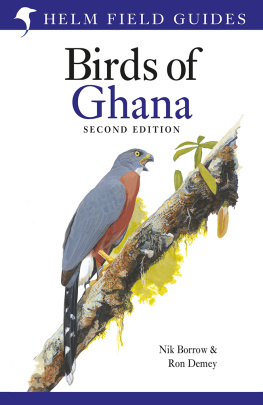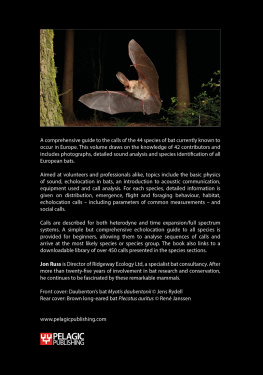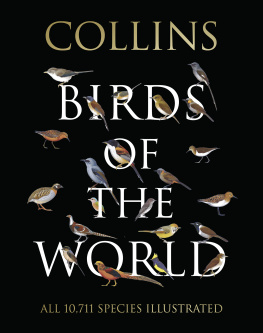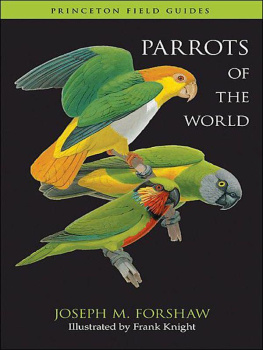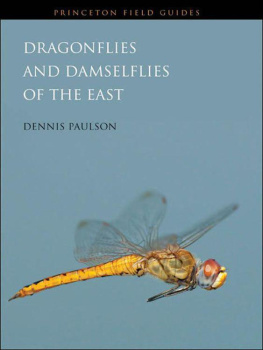
HELM IDENTIFICATION GUIDES

WARBLERS
OF EUROPE,
ASIA AND NORTH AFRICA

Kevin Baker

CHRISTOPHER HELM
A & C Black London
First published 1997 by Christopher Helm Publishers.
Digital editions published 2010 by Christopher Helm Publishers, an imprint of A&C Black Publishers Ltd, 36 Soho Square, London W1D 3QY
Copyright 1997 Kevin Baker
The right of Kevin Baker to be identified as the author of this work has been asserted by him in accordance with the Copyright, Designs and Patents Act 1988.
ISBN (print) 978-0-7136-3971-1
ISBN (epub) 978-1-4081-3170-1
ISBN (e-pdf) 978-1-4081-3521-1
A CIP catalogue record for this book is available from the British Library
All rights reserved. No part of this publication may be reproduced or used in any form or by any means photographic, electronic or mechanical, including photocopying, recording, taping or information storage or retrieval systems without permission of the publishers.
Visit www.acblack.com/naturalhistory to find out more about our authors and their books. You will find extracts, author interviews and our blog, and you can sign up for newsletters to be the first to hear about our latest releases and special offers.
CONTENTS
European, Asian and African warblers are commonly known as Old World warblers and fall into the family Sylviidae. They should not be confused with those from the New World, which are generally referred to as American wood-warblers or New World warblers (Parulinae).
The family Sylviidae encompasses over 350 species (perhaps as many as 387) in about 67 genera. Sylviidae are divided into two subfamilies: Sylviinae (Old World warblers and allies) and Polioptilinae (gnatcatchers from the Americas). One hundred and forty-five species of Sylviinae are considered in this book, which covers all those found breeding in the Palearctic, the rest of mainland Asia, and North Africa. Species found in sub-Saharan Africa, the Malay archipelago, Australasia and the Pacific Islands (unless they also occur within the Palearctic) are not covered in this book.
Warblers are frequently thought of as archetypal little brown birds, whose appearance is unspectacular, even dull, but they have always proved popular amongst birdwatchers. Although largely fairly common and widespread, they probably cause more identification problems amongst birdwatchers than any other birds. Warblers certainly command great respect, as many famous bird identification experts will tell you! However, brown warblers are not fully representative of this family since many species are colourful and striking; others can be grey or bright buff, perhaps plain, maybe with strong contrasting colours, spotted or streaked. As a rule, those that are most colourful tend to come from tropical areas, while those that are plainer hail from more temperate regions.
Warblers are typically some of the smallest of birds, for example, Goldcrest, though some are considerably larger (Large Crass Warbler). Most have fine, narrowly-pointed bills. They are largely insectivorous, but some will seasonally eat fruit, e.g. Sylvia warblers, while others may sometimes feed upon nectar, e.g. Chiffchaff, and some species even resort to seed-eating. Warblers occupy almost every type of habitat from agricultural lowlands, deserts and savannas to tropical montane forests, and dense broadleaved woodlands. In most warbler species, the sexes are identical or only slightly different. Many species within the genera Sylvia (e.g. Blackcap, Sardinian Warbler), Orthotomus (e.g. Dark-necked Tailorbird) and Regulus (e.g. Firecrest and Goldcrest) are notable exceptions to this rule. Immature plumage is generally noticeably different from adult plumage, being mostly duller and rather uniform, normally lacking spotting and contrasting patches of colour, which is mainly apparent in breeding adult male plumages, and mainly manifested as bright or dark caps, or breast bands.
Warblers occur at greatest diversity in tropical Africa (c. 134 species), compared with a much smaller number of species in tropical Asia (c. 84 species). Warblers resident in the Tropics are joined in the northern winter by over 100 species of Palearctic warbler which undertake long and very arduous migrations. In the New World, in addition to the wood-warblers (Parulinae) which represent the ecological equivalent of the Old World Sylviidae, the Sylviidae are represented by 1215 species of gnatcatchers, two species of kinglets, and by Arctic Warbler. This latter species has an established breeding population in western Alaska, yet migrates to winter in South-East Asia, in common with its Palearctic-breeding conspecifics. Arctic Warbler undertakes one of the longest migrations of any warbler; those birds breeding in Fennoscandia migrate at least 13,000 km to the wintering quarters in southern South-East Asia. This migration phenomenon is unusual as almost all other summer migrants breeding in the northwest Palearctic migrate south or southwest in late summer, to winter in parts of the Mediterranean or in Africa; on the other hand, other Palearctic warblers breeding in central and eastern Asia, migrate to winter in parts of South-East Asia. As with the western population of Arctic Warbler, there is an exception to this rule: the Siberian race of Willow Warbler undertakes a journey of similar length to Arctic Warbler, migrating from eastern Siberia to eastern Africa.
Warbler species breeding at high altitudes (essentially Himalayan species) also migrate but their movements tend to be altitudinal, moving down from the mountains in late summer to winter in the lowlands and valleys. Warblers in the Oriental and Ethiopian regions are largely sedentary.
Moult strategies in warblers are highly variable, perhaps more so than in any other passerine family. Warblers exhibit almost every recognised moult pattern, with some being very rare for species within the Palearctic. Willow Warbler, for example, is the only Palearctic warbler to undertake two complete moults in a year.
The morphology and physiology of this group of birds is clearly very variable and adds to the charm and fascination of this unique family.
Warblers of Europe, Asia and North Africa is an identification guide to all the warblers found within this region. Many species, such as prinias and tailorbirds, have never been described or illustrated in this much detail before. The book also describes recently discovered species athough there will certainly be more to discover in the years ahead.
There is still much, much more to be discovered about warblers. This guide attempts to bring together as much of the published material as possible. However, it is likely that some published papers or material have been overlooked, simply because there is such a wealth of published information. The author would, therefore, be extremely grateful to receive additional material or details of any errors which may have been made. Please address any correspondence through the publishers.
This book could not have been written without the help and advice given by the staff of the Natural History Museum at Tring. The complete national collection of warblers was made available to me, as indeed was the library. I am particularly grateful to Peter Colston who spent much time helping me sort through skins, and for his advice and expertise on warbler taxonomy and identification; also to Graham Cowles who arranged for me to take specimens out on loan.
Next page


